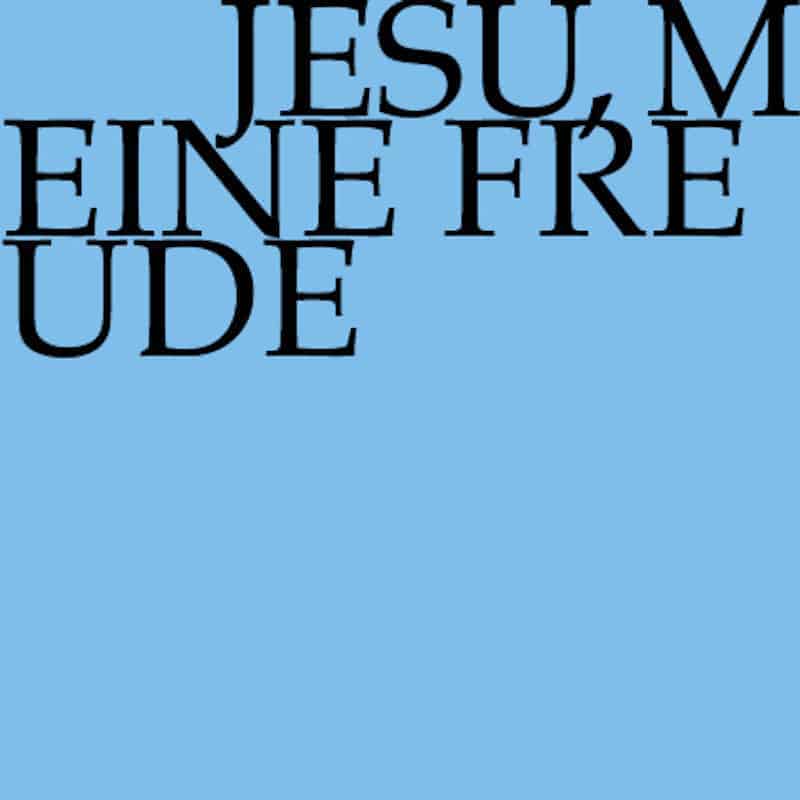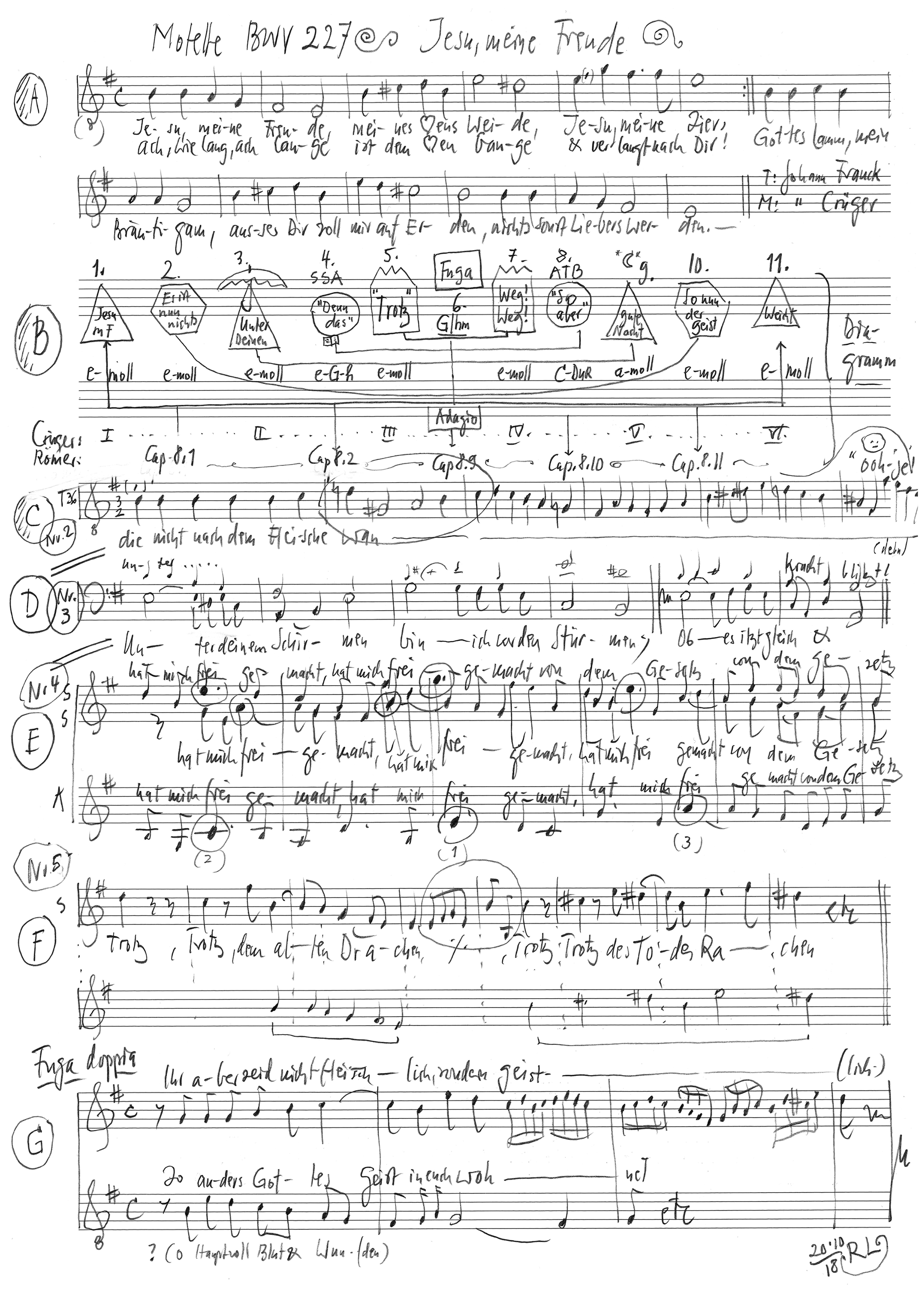Jesu, meine Freude
BWV 227 // Motet
(Jesus, my true pleasure) for vocal ensemble, oboe I+II, taille, strings and basso continuo

Would you like to enjoy our videos ad-free? Subscribe to YouTube Premium now...
Workshop
Reflective lecture
Choir
Soprano 1
Jessica Jans, Noëmi Sohn Nad, Noëmi Tran-Rediger, Alexa Vogel, Mirjam Wernli
Soprano 2
Lia Andres, Olivia Fündeling, Jennifer Ribeiro Rudin, Susanne Seitter, Maria Weber
Alto
Antonia Frey Sutter, Katharina Jud, Francisca Näf, Lea Pfister-Scherer, Simon Savoy
Tenor
Clemens Flämig, Manuel Gerber, Raphael Höhn, Sören Richter
Bass
Daniel Pérez, Retus Pfister, Grégoire May, Philippe Rayot, Jonathan Sells
Solo voices at “Denn das Gesetz”
Soprano 1: Jessica Jans
Soprano 2: Lia Andres
Alto: Simon Savoy
Solo voices at «So aber Christus»
Alto: Simon Savoy
Tenor: Raphael Höhn
Bass: Jonathan Sells
Orchestra
Conductor
Rudolf Lutz
Violin
Eva Borhi, Lenka Torgersen, Christine Baumann, Judith von der Goltz,Dorothee Mühleisen, Ildikó Sajgó
Viola
Martina Bischof, Sarah Mühlethaler, Katya Polin
Violoncello
Maya Amrein, Esmé de Vries
Violone
Markus Bernhard
Oboe
Thomas Meraner, Elise Nicolas
Taille
Ingo Müller
Bassoon
Susann Landert
Harpsichord
Thomas Leininger
Organ
Nicola Cumer
Musical director & conductor
Rudolf Lutz
Workshop
Participants
Niklaus Peter Barth, Rudolf Lutz
Reflective lecture
Speaker
Konrad Paul Liessmann
Recording & editing
Recording date
26.10.2018
Recording location
Trogen AR (Schweiz) // Evangelische Kirche
Sound engineer
Stefan Ritzenthaler, Nikolaus Matthes
Director
Meinrad Keel
Production manager
Johannes Widmer
Production
GALLUS MEDIA AG, Switzerland
Producer
J.S. Bach Foundation of St. Gallen, Switzerland
Librettist
Text
Church hymn by Johann Franck (1618–1677);
Romans 8
First performance
Funeral of Johanna Maria Kees,
on 18 July 1723
In-depth analysis
To this day, the exact occasion for the composition of Bach’s five-voice motet BWV 227 remains unknown. Nonetheless, a connection to the funeral in July 1723 of Johanna Maria Kees, a patrician citizen of Leipzig, has frequently been suggested; indeed, due to the nature of the text, in particular the verses of the chorale hymn “Jesu, meine Freude”, published by Johann Franck in 1653, it is undisputed that the occasion was a funeral. The composition alternates verses from the hymn with passages from the Epistle to the Romans, a traditional approach that is not atypical of the motets in the Altbachisches Archiv of Bach’s predecessors. The way in which the two narrative strands are integrated, however, should be seen as an innovation: rather than employing the hymn as a second melodic element to complement the Bible text or setting it as a closing movement, Bach instead continually alternates the prose passages with contrasting chorale verses, treating the hymn akin to a song partita with free insertions. This not only creates the framework for a large, highly engaging composition but also allows for the dialogue between musical sermon and interpretive reflection, which, at least from a distance, calls to mind the power of Bach’s Passion compositions.
The six chorale verse settings are highly varied in character. In the outer movements of the work – “Jesu, meine Freude” (Jesus, my true pleasure) and “Weicht, ihr Trauergeister” (Yield, ye mournful spirits) – the two soprano parts are written in unison; with their four-part writing and serene phrasing, they come across as familiar cantional settings with a binding character. By contrast, in movements three and seven – the chorale settings “Unter deinem Schirmen” (Under thy protection, in five parts) and “Weg mit allen Schätzen” (Off with other treasures, in four parts) – the accompanying voices are so accelerated and florid that a precise reading of the textual affect and the impact of words such as “kracht und blitzt” (cracks and flashes), “Hölle” (hell), and “leiden” (suffering) becomes possible.
The other two hymn verse settings “Trotz dem alten Drachen” (‘Spite the ancient serpent) and “Gute Nacht, o Wesen” (Now good night, O creature) are remarkable for their imagery. With dramatic pauses, strident unison passages and brooding coloraturas on the words “Tobe, Welt” (tremble, world), the former opens as combative music of defiance, then adopts a gesture of “sicherer Ruhe” (sure repose) in a singing confession of faith ere the final section (“Gottes Macht hält mich in Acht” – God’s great might holds me in awe) gives expression to a newly won sense of security. More reserved, by contrast, is the chorale arrangement of “Gute Nacht” (movement nine). Set for two soprano voices, alto and tenor, the music – with no bass – is freed of all earthbound life and combines an alto melody, tenor bassett, and soprano sighing figures to create an elegiac mood most fitting for a funeral.
In the five free settings of the Epistle to the Romans, the symmetric structure of the overall work is realised in a distinctive fashion. The two closely related movements of “Es ist nun nichts Verdammliches” (There is now nought of condemnation, movement two) and “So nun der Geist” (If now that spirit, movement ten) evokes a gestural-instructive spirit; through their alternating block chordal and imitative passages, the settings are akin to miniature motets complete within themselves. Two terzets, one for high voices (SSA, movement four) and one for low voices (ATB, movement eight) provide for moments of contemplative reflection; in the second, the pastoral 12 ⁄8 metre of “So aber Christus in euch ist” (If, though, now Christ doth dwell in you) gives way to joyous movement on the words “Der Geist aber ist das Leben” (the Spirit still yet is living). For the centrepiece of the motet, Bach composed an extended fugue that emphasises the spirituality of Christ’s faithful followers and, in the pressing adagio closing section, brusquely distinguishes the believer from the non-believer. As such, St Paul’s dual message of comfort and confession of faith is manifested both in the alternating narratives of the motet’s libretto and in the design of its key movement, thus transforming the hopes and promises of the unknown dedicatee during his or her lifetime into an open invitation for all choristers and listeners.
Libretto
Jesu, meine Freude,
meines Herzens Weide,
Jesu, meine Zier,
ach wie lang, ach lange
ist dem Herzen bange
und verlangt nach dir!
Gottes Lamm, mein Bräutigam,
außer dir soll mir auf Erden
nichts sonst Liebers werden.
Es ist nun nichts Verdammliches an
denen, die in Christo Jesu sind,
die nicht nach dem Fleische wandeln,
sondern nach dem Geist.
Unter deinem Schirmen
bin ich vor den Stürmen
aller Feinde frei.
Laß den Satan wittern,
laß den Feind erbittern,
mir steht Jesus bei.
Ob es itzt gleich kracht und blitzt,
Ob gleich Sünd und Hölle schrecken:
Jesus will mich decken.
Denn das Gesetz des Geistes, der da
lebendig machet in Christo Jesu, hat mich
frei gemacht von dem Gesetz der Sünde
und des Todes.
Trotz dem alten Drachen,
trotz des Todes Rachen,
trotz der Furcht darzu!
Tobe, Welt, und springe,
ich steh hier und singe
in gar sichrer Ruh.
Gottes Macht hält mich in acht;
Erd und Abgrund muß verstummen,
ob sie noch so brummen.
Ihr aber seid nicht fleischlich, sondern
geistlich, so anders Gottes Geist in
euch wohnet. Wer aber Christi Geist
nicht hat, der ist nicht sein.
Weg mit allen Schätzen!
Du bist mein Ergötzen,
Jesu, meine Lust.
Weg ihr eitlen Ehren,
ich mag euch nicht hören,
Bleibt mir unbewußt!
Elend, Not, Kreuz, Schmach und Tod
soll mich, ob ich viel muß leiden,
Nicht von Jesu scheiden.
So aber Christus in euch ist, so ist der Leib
zwar tot um der Sünde willen; der Geist
aber ist das Leben um der Gerechtigkeit
willen.
Gute Nacht, o Wesen,
das die Welt erlesen,
mir gefällst du nicht!
Gute Nacht, ihr Sünden,
bleibet weit dahinten,
kommt nicht mehr ans Licht!
Gute Nacht, du Stolz und Pracht!
Dir sei ganz, du Lasterleben,
gute Nacht gegeben.
So nun der Geist des, der Jesum von den
Toten auferwecket hat, in euch wohnet,
so wird auch derselbige, der Christum von
den Toten auferwecket hat, eure sterblichen
Leiber lebendig machen um des willen,
daß sein Geist in euch wohnet.
Weicht, ihr Trauergeister,
denn mein Freudenmeister,
Jesus, tritt herein.
Denen, die Gott lieben,
muß auch ihr Betrüben
lauter Zucker sein.
Duld ich schon hier Spott und Hohn,
dennoch bleibst du auch im Leide,
Jesu, meine Freude.



